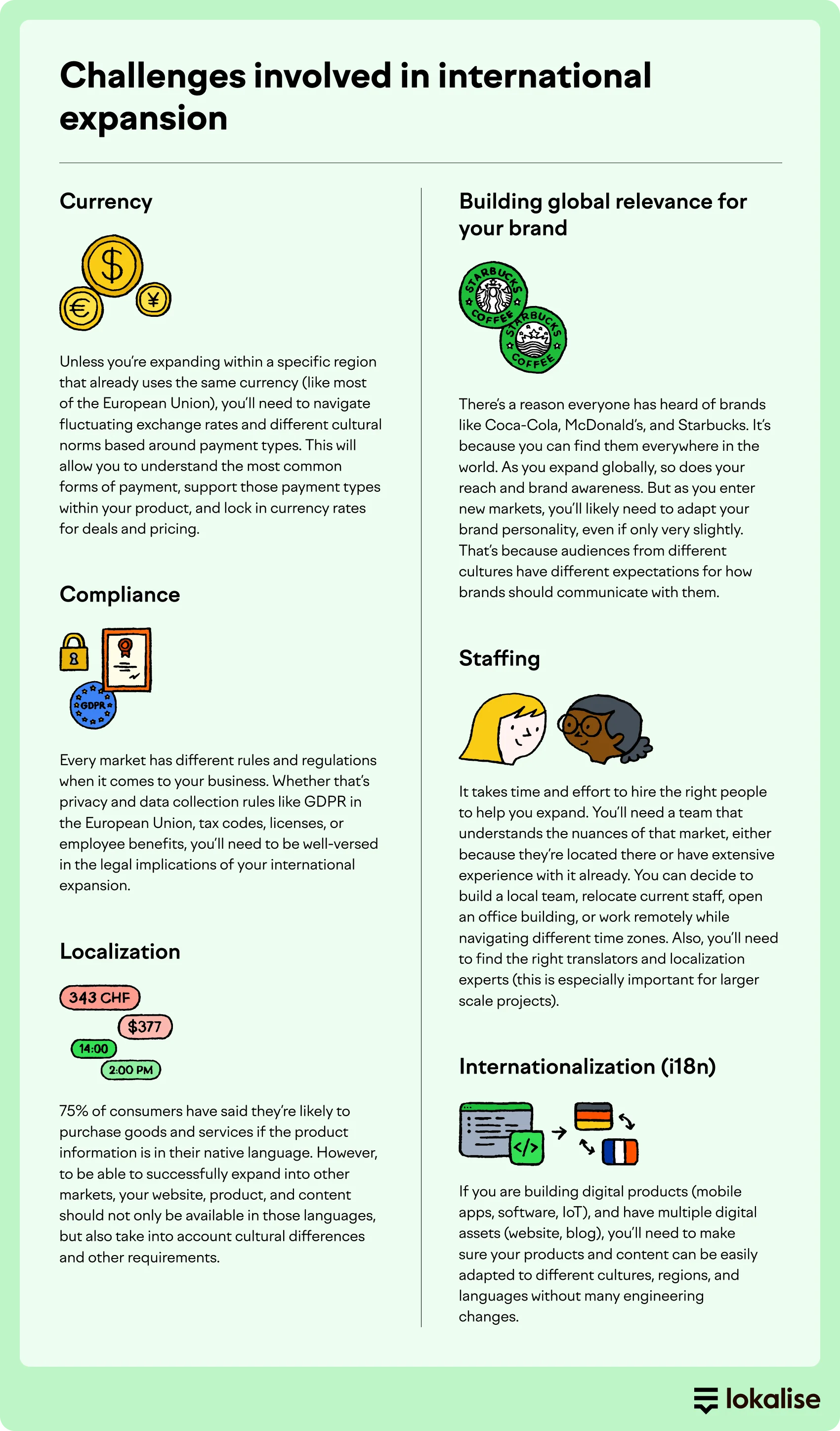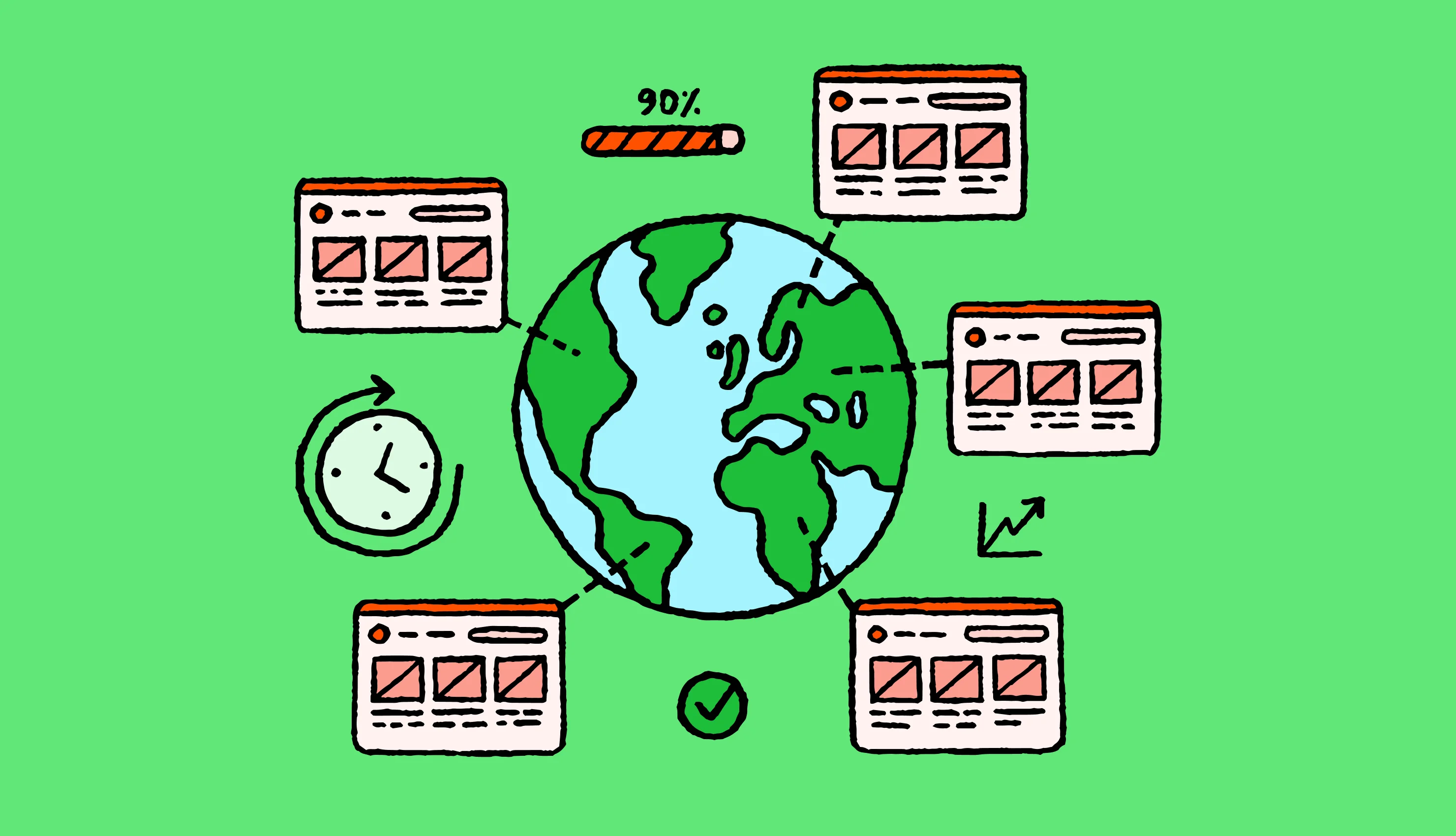International expansion is a smart business move for companies looking to increase their market share and grow. But with globalization, as you extend your operations beyond your domestic market into foreign countries, you’ll face numerous challenges.
You might need to open new offices, launch localized products or services adjusted to target markets, form partnerships, and more.
✅ Actionable insights, zero-fluff content
This article is packed with actionable insights. You’ll learn what important economical shifts are happening right now and which markets are worth expanding into. You’ll also discover four modes of international expansion, a step-by-step guide to entering new markets, and why localization matters in the process.
International expansion beyond the U.S. market
When we think about the global economies, the U.S. market might pop into our minds first as the leading force. The demand is high across many industries, the buying power is solid. But you might be surprised to learn there are important shifts happening.
In a book called “Factfulness”, Hans Rosling, one of the most influential physicians and geographers, explains four different levels of income. He goes on to elaborate how the world is gradually improving in terms of standards of living.
Rosling also pointed out how we’re probably wrong about the economic forces in the world:
“People in North America and Europe need to understand that most of the world’s population lives in Asia. In terms of economic muscles “we” are becoming the 20 percent, not the 80 percent. But many of “us” can’t fit these numbers into our nostalgic minds.”
In addition, the book explains how by 2040, 60% of Level 4 consumers will live outside the Western world, meaning that markets once considered somewhat underdeveloped will take the lead.
That’s mind-blowing, isn’t it?
If you’re interested in international expansion, but you’re not sure where to start, keep on reading.
What is international expansion?
International expansion (or globalization) is the process of expanding to foreign markets. The goal is to capture a greater share of the global market and increase revenue.
While international expansion is an exciting opportunity, there are many challenges to consider. Move too quickly, and you risk entering a market without a strong product-market fit. Move too slowly, and you risk losing out on key opportunities in favor of the local competitors. Focus to much on business translations without adapting the creative message, and your international audience might not like you very much.
The benefits of international expansion
International expansion can help you boost sales and revenue, and grow your profit margin. Additionally, it allows you to diversify business risk. You are spreading revenue across multiple markets which reduces reliance on one region. That’s also how you’re mitigating local economic downturns or market fluctuations.
Here are additional benefits of expanding your business internationally:
- Access to resources: Operating in multiple countries provides access to unique resources that may not be available in the home country. Think of a large international talent pool, technological advancements, or raw materials for certain industries.
- Faster innovation: Insights from different markets help generate new ideas and innovate, improving products and services faster.
- Competitive edge: As you expand internationally, your brand will increase its global visibility. This impacts your business in both domestic and foreign markets.
💫 Get inspired
HiBob initially began its international expansion in the UK in 2016, and has since grown its presence throughout North America, South America, and Europe. See how they managed to save up to 50% of localization costs and decrease their time-to-market.
The main four modes of international business expansion
Selecting the right way to expand your business internationally depends on various factors. Your financial resources, industry, the level of competition, and the ease of market penetration are the key things you should consider.
See the table below to discover four modes of international business expansion.
| Mode of international expansion | What is it | Who’s it for |
| Exporting | Selling goods or services produced in one country to customers in another | Best for companies with established products seeking to enter new markets with minimal investment |
| Licensing and franchising | Granting another business the right to use your brand, technology, or sell your products for a fee | Ideal for brands that want to expand quickly by leveraging local partners’ resources and networks |
| Joint partnership | Collaborating with a local company to share resources and expertise in a new market | Great option for businesses that want to share expertise and minimize risk by collaborating with a local partner |
| Strategic acquisition | Acquiring or merging with a local company to gain direct access to a foreign market. | Perfect for companies seeking immediate market access and local expertise through acquiring an established player |
In the early stages of planning your international expansion, you should ask yourself the following questions:
- Do I have the resources and infrastructure to manage direct exports, or would I prefer relying on local partners?
- Am I comfortable sharing my brand or technology with another business in exchange for fees, as in licensing or franchising?
- Would partnering with a local company help me better understand the market and reduce my risk?
- Do I want immediate market access and local expertise through acquisition, or am I willing to grow gradually?
- How much control do I want over my operations in the new market, and can I handle the complexities of different modes?
This is an important first step to figuring out what would be the best mode of international expansion for your specific business case.
5 steps to building an international expansion strategy
Expanding into international markets takes deliberate planning. Follow these steps to create an international expansion roadmap.
1. Recognize the challenges, time, and commitment necessary
Most companies struggle with international expansion, taking five years or more to see a return on their global investment. Five years!
Furthermore, the complexity that’s required to enter a new market is often neglected because companies don’t know any better. They treat l10n (localization) as an afterthought rather than an integral business process necessary for going global. This ends up costing a lot more in the long run. By integrating translation and localization early in the planning process, companies can avoid costly mistakes and better align their messaging with local cultures.
Successful international expansion requires time, patience, and commitment. Before embarking on an international expansion project, determine your goals and objectives and how you’ll balance the investments you need to make on a global level with the business you’re currently doing. You should also consider the globalization vs localization approach, deciding whether to prioritize a unified global strategy or tailor your efforts to local markets.
💡Did you know?
When it comes to international expansion, HBR determined that it takes 10 years to reach a modest +1% ROI, and only 40% of companies create more than 3%. The reason it’s so challenging? Many companies enter too many foreign markets too quickly.
2. Evaluate the opportunity to expand internationally
When expanding internationally, you need to think about the market-specific barriers and transnational strategy. These include cultural nuances and norms, different languages, unique consumer expectations, but also technical limitations (e.g., outlet voltages or smartphone settings).
More specifically, you need to look at market potential, costs of international expansion, as well as risks.
- Assess demand, competition, and growth opportunities (e.g., how large is the customer base, is the competition high, what’s the demand for your product or service)
- Identify costs of setup, operations, and market penetration (e.g., cost of marketing materials, localization, supply chains)
- Determine how much control you want over operations and decision-making (e.g., more control generally means better brand consistency, less control means more hands-off approach like with franchises)
- Evaluate political, economical, and cultural risks
Additionally, consider how software internationalization (i18n) can help you streamline the localization process, making it easier to adapt your products for diverse markets without significant overhauls.
🎥 How Netflix expanded globally
Netflix grew its global value by 72% between 2019 and 2020, according to Forbes, and part of that is due to a careful international expansion.
Rather than jumping straight into every market, they consciously evaluated each potential country for language, culture, and competitors — starting with Canada, the most similar market to their home country of the United States.
Netflix partnered with companies like Vodafone to have a Netflix button on their television remote, making it seamless for customers in other markets to engage with the platform.
3. Conduct market research
With international expansion, proper preparation is everything. Remember all the work you’ve done to launch your business in your home market? Ensuring product-market fit, doing market research through focus groups and social media, testing your idea in the wild… You must be ready to do it all over again with a new market in mind.
Analyze demand
The first thing you need to do is analyze demand. Study through consumer needs and preferences, and make sure you understand current trends. You can use Statista or pay for reports on Euromonitor for market research. You can also test locally and run a small pilot or survey.
Evaluate competition
Who are the key players you’ll potentially go against? Make sure you understand the competitive landscape and identify the total addressable market (TAM). You can use tools like IBISWorld or SimilarWeb for competitive analysis.
Regulatory compliance
The next thing you need to do is understand legal, tax, and compliance requirements. Resources like Export.gov or World Bank Doing Business can be helpful here. Remember: ignorance of law excuses no one. If you fail to comply, you might have to pay fines, go through legal investigation, or operational shutdowns.
Understand cultural nuances
You need to explore cultural nuances and decide on your localization strategy. It’s useful to partner with local business associations or to check out Hofstede Insights. Their Country comparison tool gives you high-level insights on your target market, which makes it easier to decide if it’s worth pursuing or not.

This neat interactive tool allows you to click on any dimension title below the chart to switch between dimension descriptions.
4. Commit to continuous localization
Preparing for international expansion isn’t just about building new teams abroad; it’s about ensuring your current team adapts their processes and collaborates effectively with localization partners.
For example, your product team might have a sprint cycle that ships new software updates every week. With international expansion, you’ll need to create room in that process for localization. In fact, localization should be a part of your continuous delivery workflow so it doesn’t halt product releases.
Your international expansion isn’t a one-off thing. Once you launch in a new market, you’ll need to constantly support your existence in that market.
This means that your marketing, sales, and support teams will become a part of localization. You’ll also need to create and ship new content in order to attract and retain customers in your new target market.
📚Further reading: Learn more about the value of marketing localization as you expand internationally.
5. Localize all touchpoints for a successful international expansion
Your international customers will interact with your brand in multiple ways. They might read your blog posts, visit your website, receive an email, read your social media posts, see your ads, talk to your support, and so on.
You need to localize the entire experience and carefully think about every single touchpoint. The importance of localization cannot be underestimated for a successful market launch.
[Bonus] Infographic representing challenges in international expansion
International expansion isn’t as easy as snapping your fingers and magically making your products available in other markets. To determine if you’re truly ready to become an international business (or expand your global reach into a new market), you need to be aware of the common challenges.
In the infographic below, you can see six most common challenges. From localizing currency and ensuring regulatory compliance to staffing, internationalization, and more.

International expansion and localization are easier with a system
When you plan on expanding to new markets, you’ll have different teams owning and managing parts of your market expansion strategy. And like we said, localization will play a crucial role here.
To successfully launch in a new country, you’ll need to ensure many different stakeholders stay on the same page. It truly takes a village.
Lokalise helps you successfully manage all your localization efforts in one place. No more endless back-and-forths between product managers, developers, marketers, and translators.
You’ll always know who’s doing what and the bird’s eye view will help you avoid costly mistakes. For instance, you’ll never get charged for the same translations twice, and you’d be surprised how often this happens with inefficient tools.
💡Pro tip: Not sure where to start with localization? Download our actionable localization checklist to make sure you’re on track.
Next steps
We invite you to book custom Lokalise demo and see how to implement an interconnected continuous localization workflow at your company. Worst case scenario, you’ll get tips from our localization experts that you’ll be able to immediately apply.
If you prefer to poke around Lokalise on your own, sign up for a free 14-day trial. We don’t ask for your credit card details, so this is completely risk-free.
Lokalise’s customers report an up to 37% shorter development release cycle and 8 times faster translation delivery times. More than 3,000 companies from 80+ countries, including Notion, Lemonade, Bayer, and KPMG – use Lokalise for continuous localization. Join them today.





